What Is The Difference Between Drive In Racking and Radio Shuttle Racking
For warehouses with an increasing need to store goods, making the most of space is essential. Choosing this type of warehouse racking not only helps businesses save on warehouse expansion costs but also increases storage density many times over. Among them, Drive in racking and Radio Shuttle racking receive the most attention in this segment. Let's join Au Viet Rack to compare Drive in racking and Radio Shuttle racking in detail in the article below!
Concept of Drive in racking and Radio Shuttle racking
Drive-in racking is made from a series of pallet racking creating a large storage racking system, specialized in warehouses with large quantities of homogeneous goods. The aisles are created inside the rack allowing forklifts to move deep inside each row of racks to directly pick up goods.
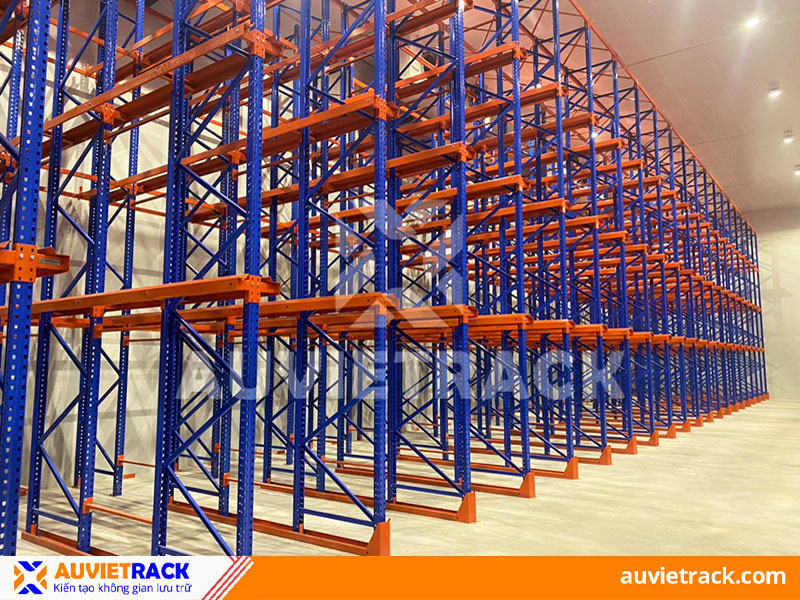 Drive in racking system in the warehouse
Drive in racking system in the warehouse
Radio Shuttle racking is a semi-automated storage solution for handling goods inside racking, similar to Drive-in racking. However, Radio Shuttle automatic racking eliminates the need for forklifts to drive into the racking system, allowing the racking system to be expanded in depth, increasing safety, speed, cost-effectiveness and time efficiency.
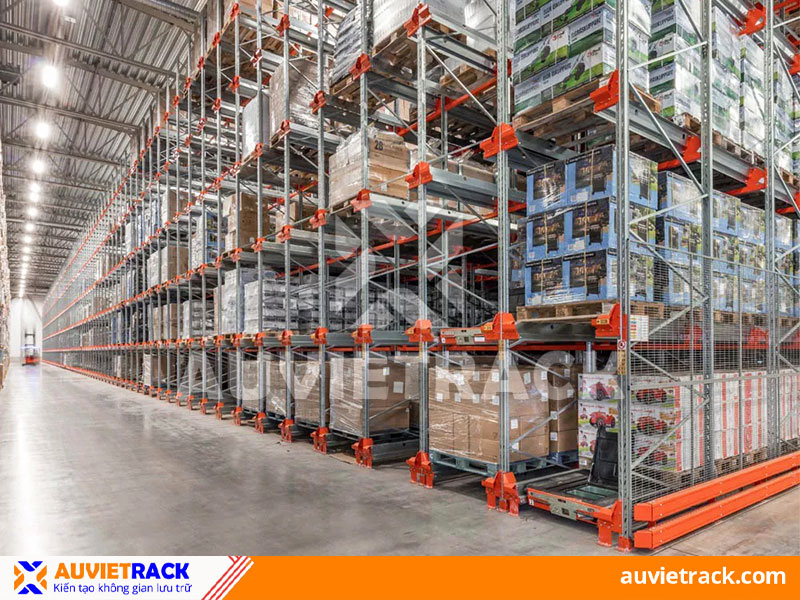 Radio Shuttle racking system in the warehouse
Radio Shuttle racking system in the warehouse
Compare the characteristics of Drive in racking and Radio Shuttle racking
1.1 Storage density
The Drive in rack system is arranged close together in clusters, significantly reducing aisles in the warehouse compared to other types of warehouse racking. Therefore, this type of rack can utilize 70% of the warehouse floor area.
Radio Shuttle racking is superior to Drive in racking in terms of storage density with a floor utilization rate of up to 80%. Radio Shuttle racking allows larger quantities of goods to be stored in the same warehouse space.
1.2 Load capacity
Both Drive in racking and Radio Shuttle racking are used to store light to very heavy goods. The allowable load capacity of these two types is in the range of 300-1500 kg/pallet.
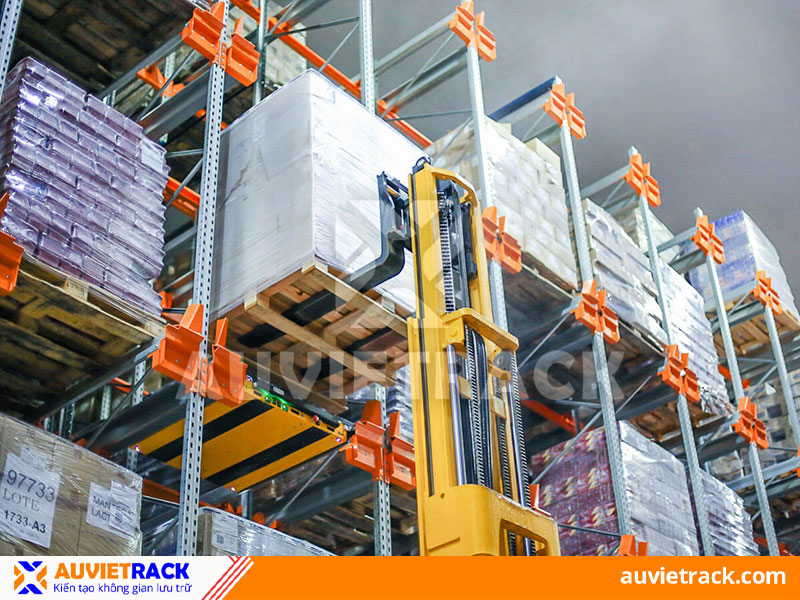 The load between the Drive in rack and the Radio Shuttle rack is the same
The load between the Drive in rack and the Radio Shuttle rack is the same
1.3 Depth of racking
The safe depth of each Drive in rack level is 15 pallets/level. Although it has the advantage of depth, Drive-in racking also needs to comply with a safe depth because if they exceed it, there is a risk of the rack collapsing.
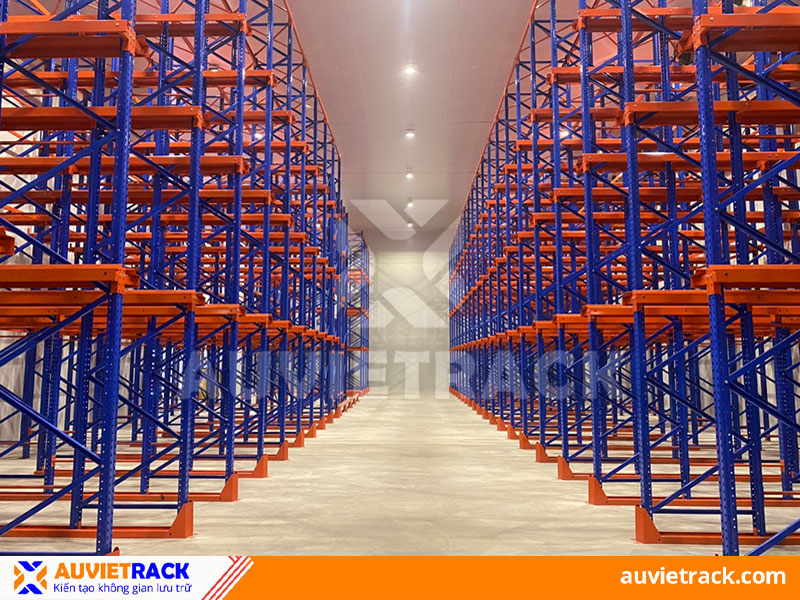 Drive in rack depth is lower than Radio Shuttle racking
Drive in rack depth is lower than Radio Shuttle racking
Radio Shuttle racking with outstanding depth of up to 40 pallets per rack level. With a depth nearly 3 times that of Drive in racking, Radio Shuttle racking becomes ideal for warehouses that need to store extremely large quantities of goods.
1.4 How to arrange racking in the warehouse
Drive-in racks are arranged with many rows of single racking placed close together. Because the depth of each rack level is not too high, the warehouse layout needs to be divided into separate rack clusters with aisles between clusters.
Thanks to the large rack depth, Radio Shuttle racks are arranged with rows of racking placed close together to form a single cluster of racking in each warehouse space. Therefore, the Radio Shuttle racking system absolutely does not need aisles between rack clusters, but only needs space in front for forklifts to load and unload goods.
1.5 Maximum height
Drive-in racks have a maximum safe height of up to 12m. With this height, Drive-in racking meets the height-based storage needs of most warehouses today.
For the Radio Shuttle rack, this is a winning point. The safe height of up to 15m is a height that is difficult for any type of rack to achieve. Therefore, this type of rack is the ideal choice for warehouses that have the advantage of height.
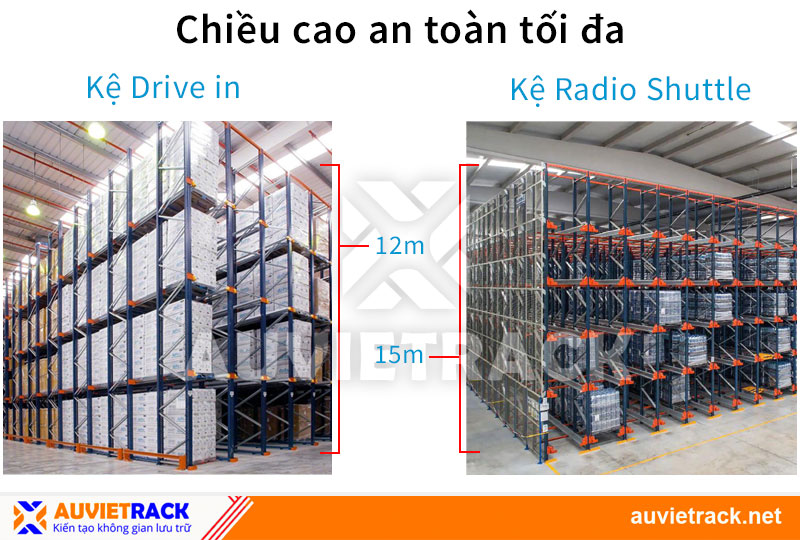 The maximum height of the Radio Shuttle rack is much higher than the height of the Drive in rack
The maximum height of the Radio Shuttle rack is much higher than the height of the Drive in rack
1.6 Load and unload principles
Drive racking is suitable for warehouses that only apply the LIFO principle (last in - first out). Goods placed first on the rack will be located deep inside, goods placed later will be on the outer position. Therefore, when loading goods, the outer pallet will be taken out first quickly before accessing the pallets inside.
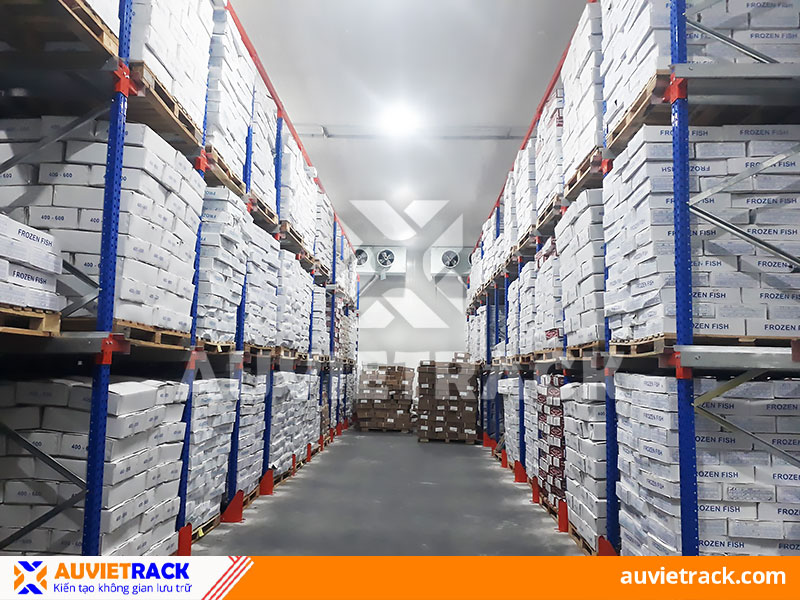 Drive in racking apply the LIFO input and output principle
Drive in racking apply the LIFO input and output principle
Radio Shuttle racking applies both LIFO and FIFO input and output principles. Depending on customer needs, during the process of arranging and installing Radio Shuttle racking, there will be changes to suit the desired load and unload principles.
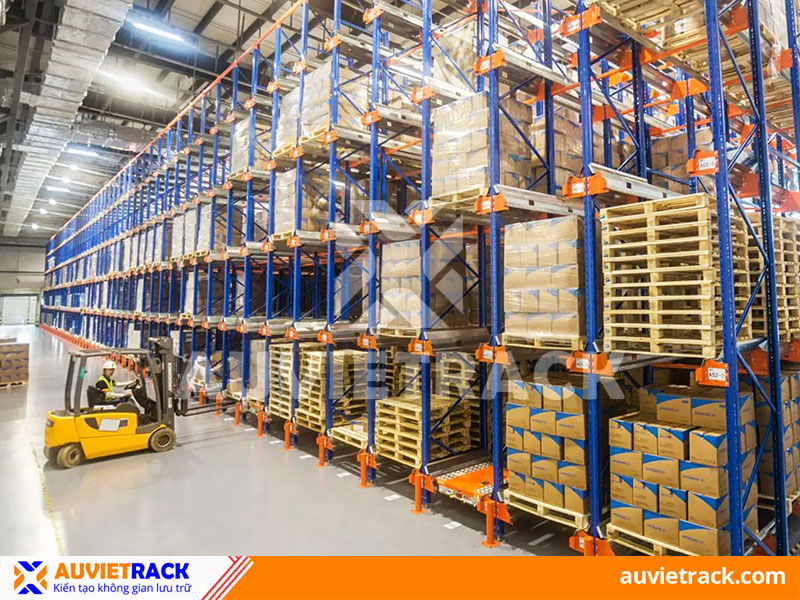 Radio Shuttle racking can apply both FIFO and LIFO principles
Radio Shuttle racking can apply both FIFO and LIFO principles
1.7 Forms of load and unload
Conventional forklifts are the main form of load and unload when using Drive in racking. When you need to pick up goods or put goods on racking, the forklift will drive directly into the rack to the desired location and lift the pallet. Drive-in racking can be used with most types of forklifts, as long as the size of the forklift is suitable to fit inside the rack’s aisle.
 The load and unload form of Drive in racking is forklift
The load and unload form of Drive in racking is forklift
Radio Shuttle racking applies today's leading smart technology to load and unload goods - the Radio Shuttle robot. The robot's speed can reach 90 m/min when not lifting goods and 45m/min when lifting goods. The forklift just needs to place the pallet on the robot, and the robot will automatically move the goods to the desired location. Therefore, the speed of load and unload of goods is very fast. Transportation outside the racking will be done by conventional forklifts.
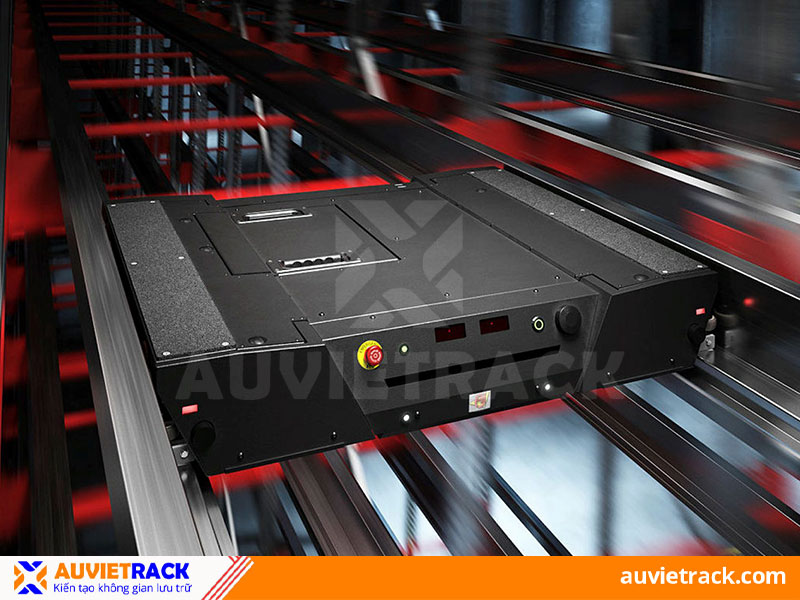 The Radio Shuttle rack uses smart robots for load and unload
The Radio Shuttle rack uses smart robots for load and unload
>>> Refer to Au Viet Rack's Radio Shuttle rack price list here
1.8 Type of goods and pallets used
For Drive in racking, the difficulty of accessing pallets deep inside is also a factor affecting the quality of goods. Goods with a long shelf life are considered most suitable for using this type of rack.
 Drive in racking are suitable for storing goods with a long shelf life
Drive in racking are suitable for storing goods with a long shelf life
In contrast, Radio Shuttle racking allows the storage of goods with a short shelf life if the warehouse applies the FIFO principle.
The common point between these two types of racking is that they are not suitable for warehouses that need to store many types of goods (sku) on a racking system. Besides, pallets used throughout the racking system must have the same specifications and dimensions.
1.9 Safety level between Drive in rack and Radio Shuttle rack
Driving a forklift into the Drive-in racking also causes more safety concerns. The risk of collision between forklifts and racking is quite high, which can cause damage to racking and goods if the forklift operator is not highly qualified.
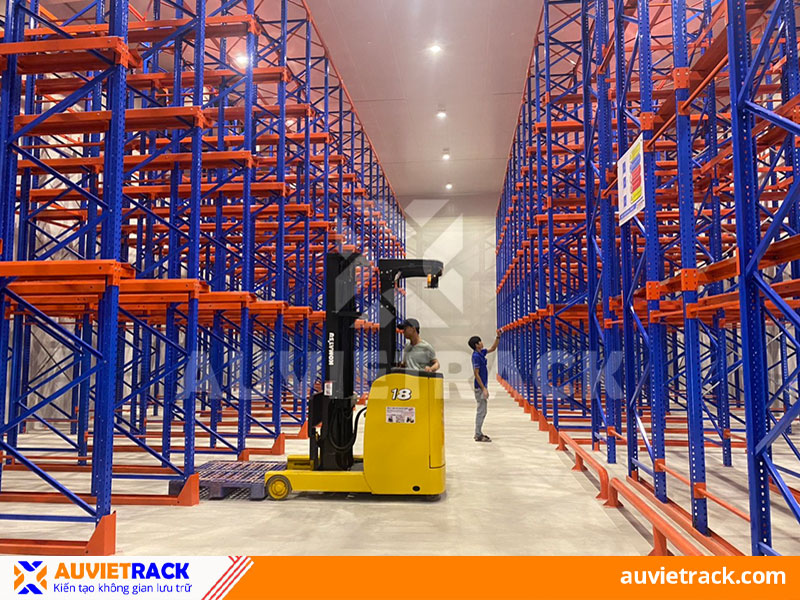 Drive in racking should be used with care
Drive in racking should be used with care
For Radio Shuttle racking, the rate of collision incidents or goods damage is very low, almost non-existent. This is quite understandable because the load and unload process has been automated by the Radio Shuttle robot (Pallet Shuttle). Goods, racking and people are all guaranteed the best safety.
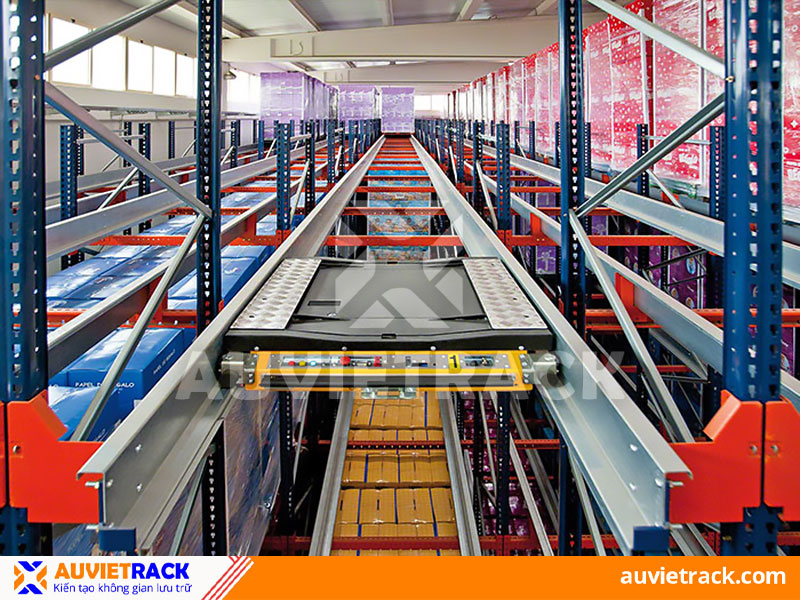 Absolute safety when storing goods using Radio Shuttle racking
Absolute safety when storing goods using Radio Shuttle racking
1.10 Investment costs
Drive in racking has a relatively low investment cost among high-density storage racking. In addition, this type of rack can be used with all common types of forklifts. This is also a great advantage that makes many investors choose Drive in racking for their warehouses.
>>> See the latest updated Drive in rack price quote for 2023
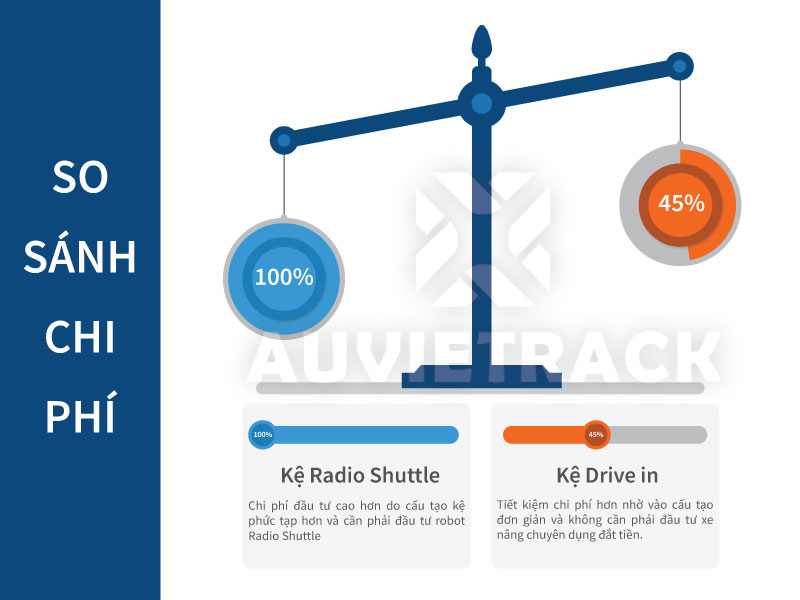 The investment cost of Radio Shuttle racking is higher than that of Drive in racking
The investment cost of Radio Shuttle racking is higher than that of Drive in racking
The Radio Shuttle rack structure is somewhat more complicated, so it is obvious that the rack cost is higher than that of Drive in. The Radio Shuttle robot applies the most advanced technology today so its price is not cheap, the investment cost is 50-60% higher than the Drive in rack. Therefore, for investors who want to "spend heavily" to bring their own technology into the warehouse, this is the brightest choice.
On the other hand, when used for a long time, the automatic operating process will help investors save labor costs. The budget for repairing the rack system is also minimized because collision incidents and rack damage are extremely low.
Summary table comparing Drive in racking and Radio Shuttle racking in the most detail
|
Comparison Criteria |
Drive in racking |
Radio Shuttle racking |
|
Storage Density |
High storage density |
High storage density |
|
Load Capacity |
300-1500 kg/pallet |
300-1500 kg/pallet |
|
Depth of Racking |
15 pallet/level |
40 pallet/level |
|
Maximum Height |
12 meters |
15 meters |
|
Load and Unload Principles |
LIFO |
FIFO, LIFO |
|
Forms of Load and Unload |
Conventional forklift |
Robot Radio Shuttle (Pallet Shuttle) |
|
Load and Unload Speed |
Not high |
High |
|
Type of Goods |
The product has a long shelf life |
There is no expiration date required |
|
Pallet Requirements |
Pallets must be uniform in specifications and size |
Pallets must be uniform in specifications and size |
|
Racking Price |
Both racks and forklifts are much cheaper than Radio Shuttle racking |
The cost of racks and robots is 50-60% higher than Drive in racking |
|
Safety Level |
The possibility of collision between forklifts and racks is high if not operated carefully |
Absolute safety, the risk of collision is very rare |
Which one should be bought? Drive in racking or a Radio Shuttle racking?
Each type of warehouse has different storage needs, so investors need to consider carefully to choose the most suitable type of rack.
Compare Drive in racking and Radio Shuttle racking.
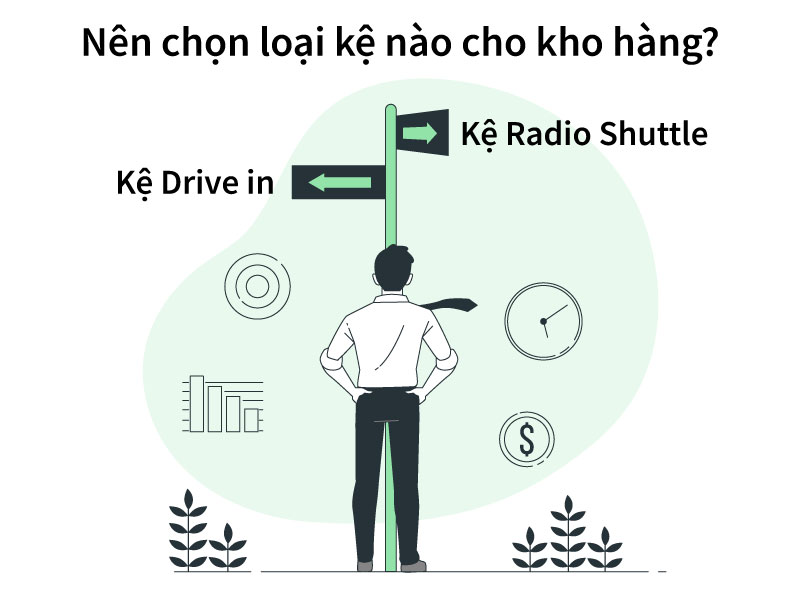
For warehouses that do not need to load and unload goods quickly and continuously, goods have a long shelf life and want to save investment costs, Drive in racking can meet the needs well.
If the warehouse needs extremely high storage density, needs to continuously load and unload at a fast speed, maximum safety, and diversify load and unload principles, there is no better choice than the Radio Shuttle racking.
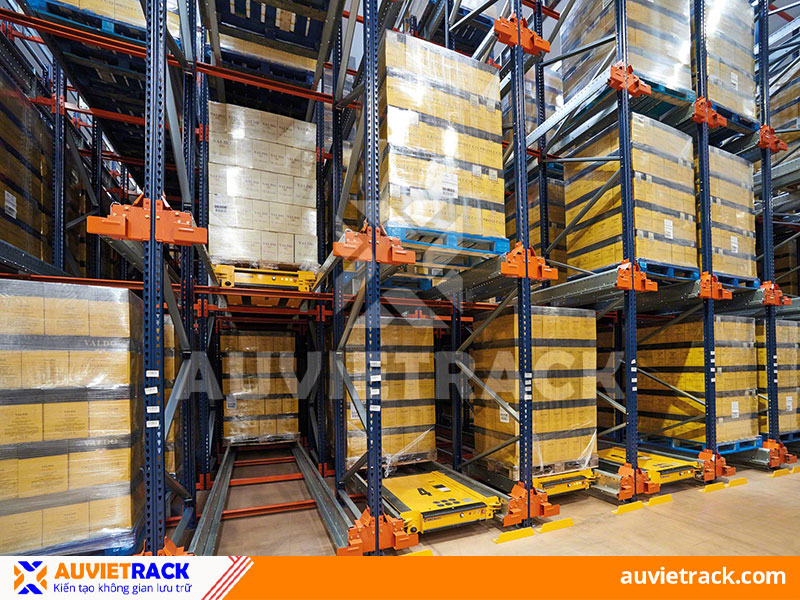
Above are the differences between the two types of warehouse racking: Drive in and Radio Shuttle. Au Viet Rack hopes to provide the most objective view and help customers better understand these two types of racking. If you have any questions, please contact Au Viet Rack immediately for quick and dedicated advice.
